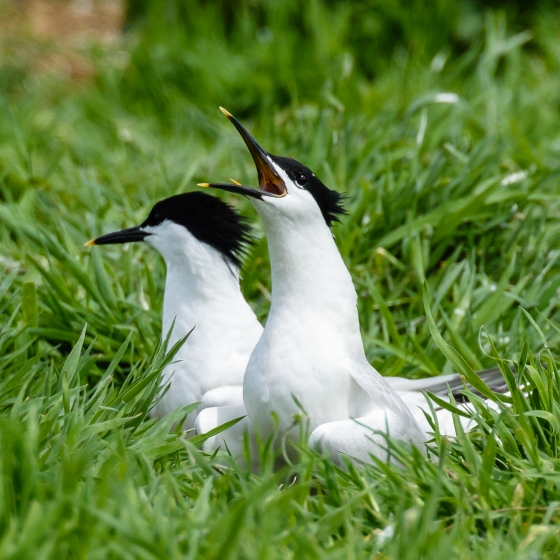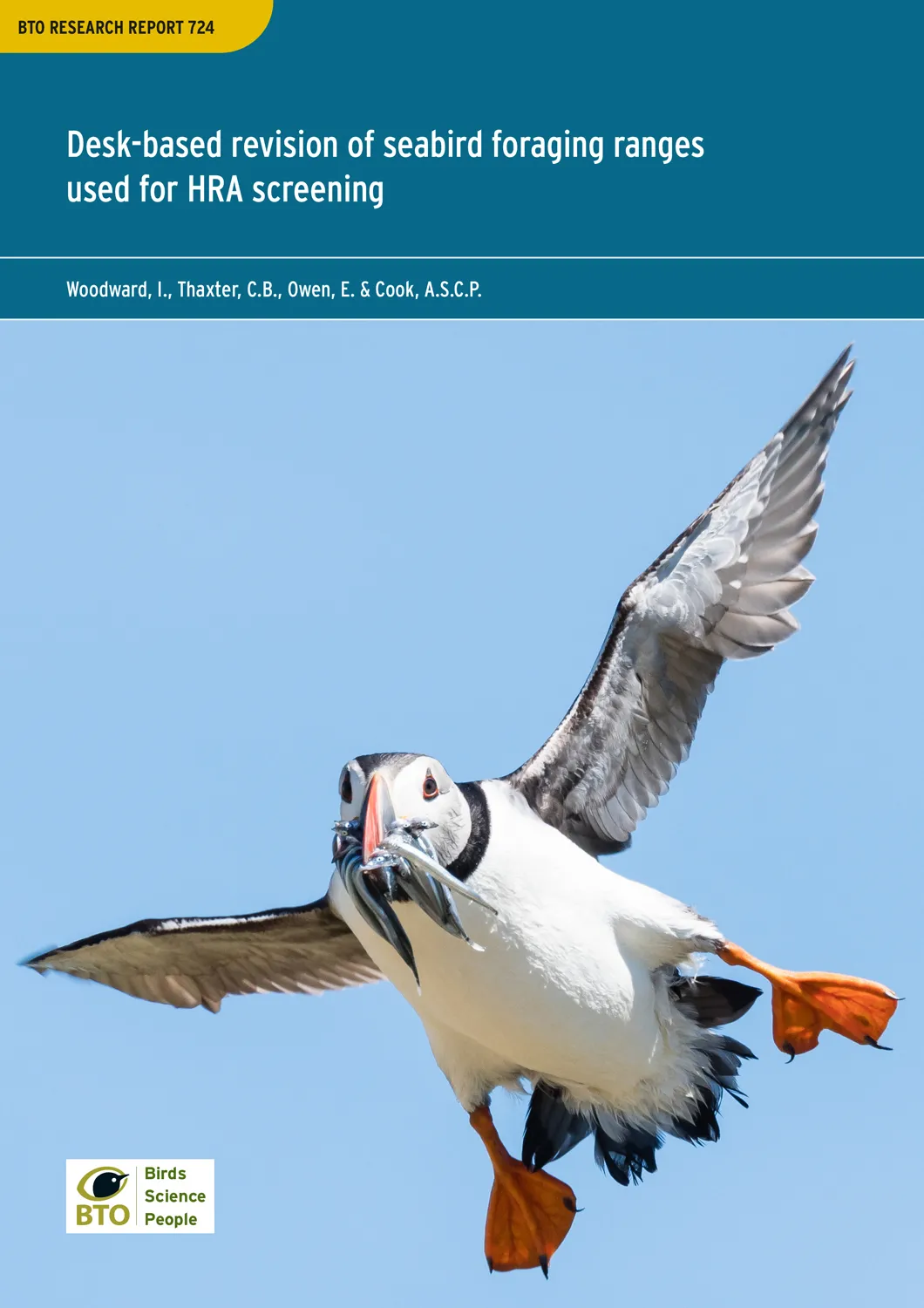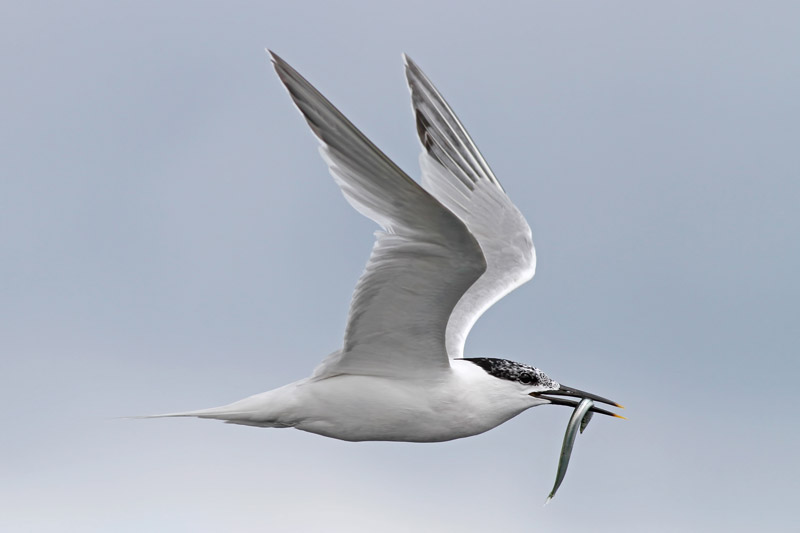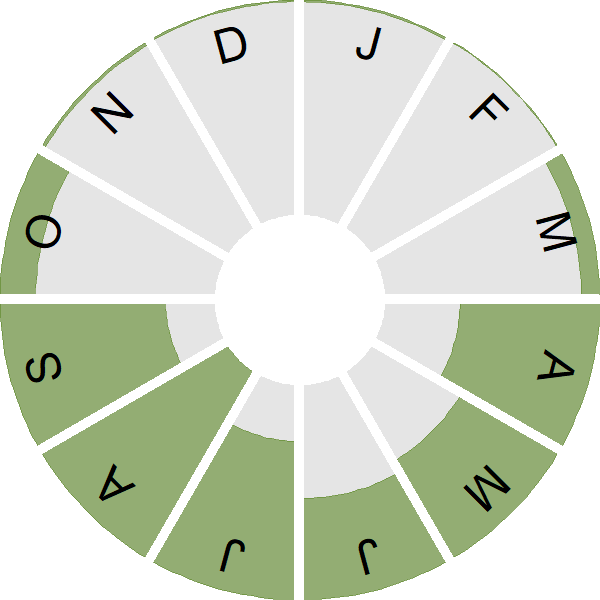Sandwich Tern

Introduction
A summer visitor to the UK, this shaggy-crested tern breeds exclusively on the coast in colonies, from the Isles of Scilly to Orkney.
A few Sandwich Terns can be seen in British and Irish waters during the winter months but most leave during autumn for the coast of West Africa.
Around 2,000 Sandwich Terns are ringed at their British and Irish breeding colonies each year; the BTO Online Ringing Report records several individuals reaching ages in their late twenties and covering distances on migration in excess of 4,000 km to their wintering locations.

Key Stats
Identification
ID Videos
This section features BTO training videos headlining this species, or featuring it as a potential confusion species.
Tern Identification Workshop Part 2: Roseate, Sandwich and Little Terns
Songs and Calls
Call:
Flight call:
Status and Trends
Conservation Status
Population Change
The Sandwich Tern population has remained relatively stable over the period covered by seabird censuses, with a moderate increase of 33% between 1969–70 and 1985–88 being followed by a shallow decrease of 15% up to the Seabird 2000 Census (1998–2002) (Ratcliffe et al. 2000). Results are not yet available from the most recent Census (Seabirds Count 2015–2021), but annual monitoring by the Seabird Monitoring Programme suggests that the relative stability of the population has continued to at least 2019 (JNCC 2022).
Distribution
Sandwich Terns breed in a relatively small number of large colonies scattered around the coasts of Britain and Ireland. Sandwich Tern is a regular wintering species, albeit it in very small numbers, along the North Sea coast southwards from the Firth of Forth and more regularly along the English south coast and around the Channel Islands. In Ireland records were clustered around Strangford Lough in the northeast and inner Galway Bay in the west.
Occupied 10-km squares in UK
2007/08–10/11
or view it on Bird Atlas Mapstore.
2008–11
or view it on Bird Atlas Mapstore.
European Distribution Map
Distribution Change
Colonies can move annually in response to changing conditions. Consequently, the distribution change map is marked by a mix of gains and losses, although overall a 22% range contraction is apparent since the 1968–72 Breeding Atlas.
Change in occupied 10-km squares in the UK
from 1981–84 to 2007–11
or view it on Bird Atlas Mapstore.
from 1968–72 to 2008–11
or view it on Bird Atlas Mapstore.
Seasonality
Sandwich Terns are mostly summer visitors and passage migrants in spring and autumn, although small numbers winter on the south coast.
Weekly pattern of occurrence
The graph shows when the species is present in the UK, with taller bars indicating a higher likelihood of encountering the species in appropriate regions and habitats.

Movement
Britain & Ireland movement
Foreign locations of birds ringed or recovered in Britain & Ireland
Dots show the foreign destinations of birds ringed in Britain & Ireland, and the origins of birds ringed overseas that were subsequently recaptured, resighted or found dead in Britain & Ireland. Dot colours indicate the time of year that the species was present at the location.
- Winter (Nov-Feb)
- Spring (Mar-Apr)
- Summer (May-Jul)
- Autumn (Aug-Oct)

European movements
EuroBirdPortal uses birdwatcher's records, such as those logged in BirdTrack to map the flows of birds as they arrive and depart Europe. See maps for this species here.
The Eurasian-African Migration Atlas shows movements of individual birds ringed or recovered in Europe. See maps for this species here.
Biology
Productivity and Nesting
Nesting timing
Egg measurements
Clutch Size
Survival and Longevity
Survival is shown as the proportion of birds surviving from one year to the next and is derived from bird ringing data. It can also be used to estimate how long birds typically live.
View number ringed each year in the Online Ringing Report.
Lifespan
Survival of adults
Survival of juveniles
Biometrics
Wing length and body weights are from live birds (source).
Wing length
Body weight
Ring Size
Classification, names and codes
Classification and Codes
- Order: Charadriiformes
- Family: Laridae
- Scientific name: Thalasseus sandvicensis
- Authority: Latham, 1787
- BTO 2-letter code: TE
- BTO 5-letter code: SANTE
- Euring code number: 6110
Alternate species names
- Catalan: xatrac becllarg
- Czech: rybák severní
- Danish: Splitterne
- Dutch: Grote Stern
- Estonian: tutt-tiir
- Finnish: riuttatiira
- French: Sterne caugek
- Gaelic: Steàrnag-mhòr
- German: Brandseeschwalbe
- Hungarian: kenti csér
- Icelandic: Þaraþerna
- Irish: Geabhróg Scothdhubh
- Italian: Beccapesci
- Latvian: cekulzirinš
- Lithuanian: margasnape žuvedra
- Norwegian: Splitterne
- Polish: rybitwa czubata
- Portuguese: garajau
- Slovak: rybár sivý
- Slovenian: kricava cigra
- Spanish: Charrán patinegro
- Swedish: kentsk tärna
- Welsh: Môr-wennol Bigddu
Research
Causes of Change and Solutions
Causes of change
Although the population has remained relatively stable, annual productivity is highly variable (JNCC 2022) and predation by foxes may be a major driver affecting productivity and causing abandonment of some colonies (Ratcliffe et al. 2000)
Publications (9)
Desk-based revision of seabird foraging ranges used for HRA screening
Author: Woodward, I., Thaxter, C.B., Owen, E. & Cook, A.S.C.P.
Published: 2019
A key step in understanding the possible impacts of a proposed windfarm development is to identify potential interactions between seabird breeding colonies and the proposed development areas. Such interactions are typically assessed using generic information on foraging ranges, derived from academic studies. This report uses the latest data to provide updated estimates of foraging range, which will help to ensure that the best available information is available when new developments are being considered.
01.12.19
BTO Research Reports

The status of the UK’s breeding seabirds
Author: Stanbury, A.J., Burns, F., Aebischer, N.J., Baker, H., Balmer, D., Brown, A.F., Dunn, T., Lindley, P., Murphy, M., Noble, D.G., Owens, R. & Quinn, L.
Published: 2024
Five seabird species are added to the Birds of Conservation Concern Red List in this addendum to the 2021 update, bringing the total number of Red-listed seabird species to 10, up from six since seabirds were last assessed. The Amber List of seabirds moves from 19 to 14 species, and the Green List increases from one to two species.
29.09.24
Papers

Seabird Population Trends and Causes of Change: 1986–2023
Author: Harris, S.J., Baker, H., Balmer, D.E., Bolton, M., Burton, N.H.K., Caulfield, E., Clarke, J.A.E., Dunn, T.E., Evans, T.J., Hereward, H.R.F., Humphreys, E.M., Money, S. and O’Hanlon, N.J.
Published: 2024
This report presents the latest seabird population trends in breeding abundance and productivity using data from the Seabird Monitoring Programme (SMP).The report documents changes in the abundance and productivity of breeding seabird species in Britain and Ireland from 1986 to 2023, and provides a detailed account of the 2021, 2022 and 2023 breeding seasons. This report includes both inland and coastal populations and trends from the Channel Islands, England, Isle of Man, Northern Ireland, Scotland, Wales and the Republic of Ireland, which are presented where sufficient data are available. The results from this report are used more broadly to assess the health of the wider environment, to inform policy and for conservation action.
21.11.24
Reports SMP Report

Impacts of highly pathogenic avian influenza on seabird populations in the North Sea are detectable in sea-watchers’ migration counts
Author: Macgregor, C.J., Gillings, S., Balmer, D.E., Boersch-Supan, P.H., Harris, S.J., Hereward, H.F.R., Humphreys, E.M., Pearce-Higgins, J.W., Taylor, R.C., Troost, G. & Atkinson, P.W.
Published: 2024
BTO research reveals that seabird population declines due to High Pathogenicity Avian Influenza (HPAI) can be detected using data collected by volunteer seawatchers.
28.12.24
Papers

Northern Ireland Seabird Report 2023
Author: Booth, K.J. & El Haddad, H.
Published: 2024
The report includes detailed information about the population trends and breeding success of seabirds in Northern Ireland, over the 2023 breeding season. Notably, Fulmar and Kittiwake populations are reported to be experiencing continued declines, while Guillemot, Common Gull and Herring Gull populations show increases at most breeding sites. Low productivity was reported in Black-headed Gulls, Sandwich Terns and Common Terns, likely due to the impacts of highly pathogenic avian influenza (HPAI). Although Black-headed Gulls make up the majority of confirmed HPAI mortality cases in Northern Ireland in 2023, other birds significantly affected include terns, Kittiwakes and auks. A contributor report about HPAI in Northern Ireland by Ronan Owens (Higher Scientific Officer, DAERA, NIEA) details developments in environmental organisations’ responses to HPAI in 2023, including cross-sector communication, improved surveillance and monitoring of HPAI impacts, and improved online systems for the public to report dead birds. Monitoring reports for Strangford Lough and the Outer Ards are included, as well as several additional contributor articles: Copeland gull censuses, by Roisin Kearney (Assistant Conservation Officer, RSPB). The Copeland Islands host one of the largest mixed gull colonies in Northern Ireland, with significant numbers of Lesser Black-backed Gulls and Herring Gulls. The annual gull census was established in 2018; the article details the refinement of the methodology to date as well as the census results so far. Manx Shearwater tracking, by Patrick Lewin (DPhil Student, OxNav, Dept. of Biology, University of Oxford). Tracking the Manx Shearwaters that breed on Lighthouse Island (one of the three Copeland Islands) began in 2007. The article describes the history of tracking Manx Shearwaters from Copeland, including recent advances in technology that have allowed the tracking of fledgling birds as well as adults of breeding age, and the impact of this research on the conservation of shearwaters. Puffin surveys on Rathlin, by Ric Else (Life RAFT Senior Research Assistant, RSPB). Rathlin Island hosts Northern Ireland’s largest seabird colony. The response of seabirds to the removal of introduced Ferrets and Brown Rats from Rathlin is currently being monitored, with a particular focus on Puffins. These birds are especially vulnerable to mammalian predators because of their burrow nests. The article describes the challenges associated with calculating a population estimate, monitoring productivity and mapping the distribution of this species, and how these are being addressed in seabird surveys on Rathlin.
15.04.24
Reports Northern Ireland Seabird Report

Behavioural responses of Sandwich terns following the construction of offshore wind farms
Author: Thaxter, C.B., Green, R.M.W., Collier, M.P., Taylor, R.C., Middelveld, R.P., Scragg, E.S., Wright, L.J., Cook, A.S.C.P. & Fijn, R.C.
Published: 2024
GPS tracking sheds light on the ‘barrier effects’ of offshore wind farms, where renewable energy developments may act as obstacles that impede the movements of seabirds to and from their colonies during the breeding season, or on migration. Between 2016 and 2019, BTO scientists fitted Sandwich Terns breeding at Scolt Head Island in Norfolk with long-life GPS tags which tracked the birds’ movements over multiple years. When the research began, there were five operational offshore wind farms within the distance that Sandwich Terns are known to fly on foraging trips. Two more offshore wind farms were under construction, and became operational during the course of the study. The results revealed that Sandwich Terns entered offshore wind farms, but the extent to which they used these areas varied over time and between sites. For the two wind farms that were completed during the study, there was a marked reduction in the amount of time birds spent at these sites between the first and second year of operation. Although birds sometimes entered offshore wind farms while foraging, they appeared to avoid them when commuting between foraging areas and their colony. This created an apparent ‘funnelling’ effect between important feeding locations. The changes found could be driven by changes to the birds’ sandeel prey distribution, avoidance of wind farms, or changes in airflow patterns following wind farm construction. The study shows that the responses of seabirds to offshore wind farms are many and complex. Further research is needed to fully understand the nature of these interactions, at a time when ever more wind farms are being constructed to mitigate the impacts of climate change.
17.01.24
Papers

Avoidance of offshore wind farms by Sandwich Terns in the North Sea increases with turbine density
Author: van Bemmelen, R.A., Leemans, J.J., Collier, M.P., Green, R.M.W., Middelveld, R.P., Thaxter, C.B. & Fijn, R.C.
Published: 2023
Offshore wind energy is considered an essential part of humanity’s transition away from fossil fuels, but it is important to understand the consequences that wind farms can have for wildlife. In this study, GPS data revealed how breeding Sandwich Terns avoid offshore wind farms in the North Sea. The study, led by Waardenburg Ecology in the Netherlands, used data from GPS tracking of breeding Sandwich Terns carried out at Scolt Head, Norfolk, and De Putten in the Netherlands between 2016 and 2021. Scolt Head had four operational offshore wind farms nearby (within the distance that Sandwich Terns are known to fly when searching for food), and De Putten had three. The authors examined the terns’ so-called ‘macro-avoidance rate’, which is the rate at which birds avoid entering an offshore wind farm altogether. This avoidance amounts to habitat loss, since the birds will no longer use this area of the sea, and perhaps incur additional energetic costs by flying around wind farms or having to forage in less optimal alternative areas. The results showed that Sandwich Terns reduced their use of the Dutch offshore wind farms areas by 41%, and British offshore wind farms by 54%. Birds were more likely to avoid wind farms the closer together the turbines were. This study’s findings could inform not only the positioning of future offshore wind farm developments, but also their design, as taller, more widely spaced turbines could be preferable to shorter, most densely packed ones in terms of minimising any detrimental effects on Sandwich Terns and related species.
18.10.23
Papers

Birds of Conservation Concern Wales 4: the population status of birds in Wales
Author: Johnstone, I.G., Hughes, J., Balmer, D.E., Brenchley, A., Facey, R.J., Lindley, P.J., Noble, D.G. & Taylor, R.C.
Published: 2022
The latest review of the conservation status of birds in Wales. The report assessed all 220 bird species which regularly occur in Wales. There are now 60 species of bird on the Red List, with 91 on the Amber List and just 69 - less than a third of the total number of species - on the Green List. The latest review of the conservation status of birds in Wales comes 20 years after the first, when the Red List was less than half the length it is today. The report assessed all 220 bird species which regularly occur in Wales. There are now 60 species of bird on the Red List in Wales, with 91 on the Amber List and 69 on the Green List. The Birds of Conservation Concern in Wales report assesses the status of each species against a set of objective criteria. Data sources include the BTO/JNCC/RSPB Breeding Bird Survey and the BTO/RSPB/JNCC Wetland Bird Survey, as well as Bird Atlases and other BTO-led monitoring schemes and citizen science initiatives. These are used to quantify the changing status of the species’ Welsh population. The UK, European and global conservation status of the species is also considered, placing the Welsh population into a wider context. The Red ListSwift, Greenfinch and Rook – familiar breeding species in steep decline across the UK – are among the new additions to the Welsh Red List, which now also includes Purple Sandpiper, on account of a rapidly shrinking Welsh wintering population, and Leach’s Petrel, an enigmatic seabird in decline across its global range. These species now sit alongside well-known conservation priorities, such as Curlew, Hen Harrier and Turtle Dove as birds at risk of being lost from Wales for good. Uplands and woodlands Many of the species on the Red List are found in upland and farmland habitats. Starling, Tree Sparrow, Yellow Wagtail and Yellowhammer can no longer be found in much of Wales, while iconic species of mountain and moorland, such as Ring Ouzel, Merlin and Black Grouse, remain in serious trouble. Wales is well known for its populations of woodland birds; however, many of these – including Lesser Spotted Woodpecker, Willow Warbler and Spotted Flycatcher – also feature on the Red List. Goldcrest, which has seen its Welsh population shrink alarmingly in recent decades, is another new addition. On the coast The assessment for Birds of Conservation Concern Wales 4 took place before the impacts of avian influenza could be taken into account. Breeding seabird species have been struggling in Wales for many years, however, and most were already of conservation concern before the outbreak of this disease. Kittiwake, Puffin, Black-headed Gull, and Common, Arctic and Sandwich Tern remain on the Red List. Wales holds internationally significant numbers of breeding seabirds, making the decline of these colonies a global concern. The Amber ListDeclines in Wheatear, Garden Warbler and House Martin - all migrants which breed in Europe and winter in sub-Saharan Africa - mean these species have moved from the Green List to the Amber List. Many other ‘Afro-Palearctic' migrant species are also in decline, but the potential reasons for this, such as habitat loss and reduced availability of invertebrate prey, are not well understood. Closer to home, the declines in the Welsh Chaffinch population, linked to the disease trichomonosis, have seen the species Amber-listed. A number of other species have been placed on the Amber List because of the wider importance of their Welsh populations, which in each case make up more than half the UK total. Wales is home to more than three-quarters of the UK’s Choughs, for example, so recent declines are cause for concern. The nation’s breeding populations of Manx Shearwater, Pied Flycatcher, Goshawk and Hawfinch also account for more than half the UK total, as does its wintering population of Spotted Redshank. It’s not all bad news, though: some species now on the Amber List have moved up from the Red List, indicating some positive change in their population trends. These include Common Sandpiper, Great Black-backed Gull, Bullfinch, Goldcrest and Pied Flycatcher. The Green ListWhile the report contains much cause for alarm, several conservation success stories shine through. Red Kite was almost lost as a British bird during the first half of the 20th century, when only a handful of pairs remained in remote Welsh valleys. Since then, a sustained conservation effort has brought the species back from the brink. Wales is now home to more than 2,500 pairs of Red Kite and the species has now been moved to the Green List, reflecting this incredible change in fortunes. Song Thrush, Reed Bunting, Long-tailed Tit, Redwing and Kingfisher are among the other species to have gone Green, providing much-needed hope that things can go up as well as down.
06.12.22
Reports Birds of Conservation Concern

Relative roles of static and dynamic abiotic conditions as drivers of foraging behaviour in breeding Sandwich Terns
Author: Fijn, R.C. Thaxter, C.B., Geert Aarts, G., Adema, J., Middelveld, R.P. & van Bemmelen, R.S.A.
Published: 2022
New research involving BTO used GPS tagging to examine Sandwich Tern foraging behaviour during the breeding season. Like other seabirds, Sandwich Terns are so-called ‘central place foragers’ while they are incubating eggs and feeding chicks, shuttling to and from their nest site in search of food. However, successfully finding food on each trip away from the nest requires navigating a continually changing marine environment and relocating moving prey.
30.06.22
Papers

More Evidence
More evidence from Conservation Evidence.com
Partners
Citing BirdFacts
If you wish to cite particular content in this page (e.g. a specific value) it is best to use the original sources as linked in the page. For a more general citation of the whole page please use: BTO (20XX) BirdFacts Species: profiles of birds occurring in the United Kingdom. BTO, Thetford (www.bto.org/birdfacts, accessed on xx/xx/xxxx).

